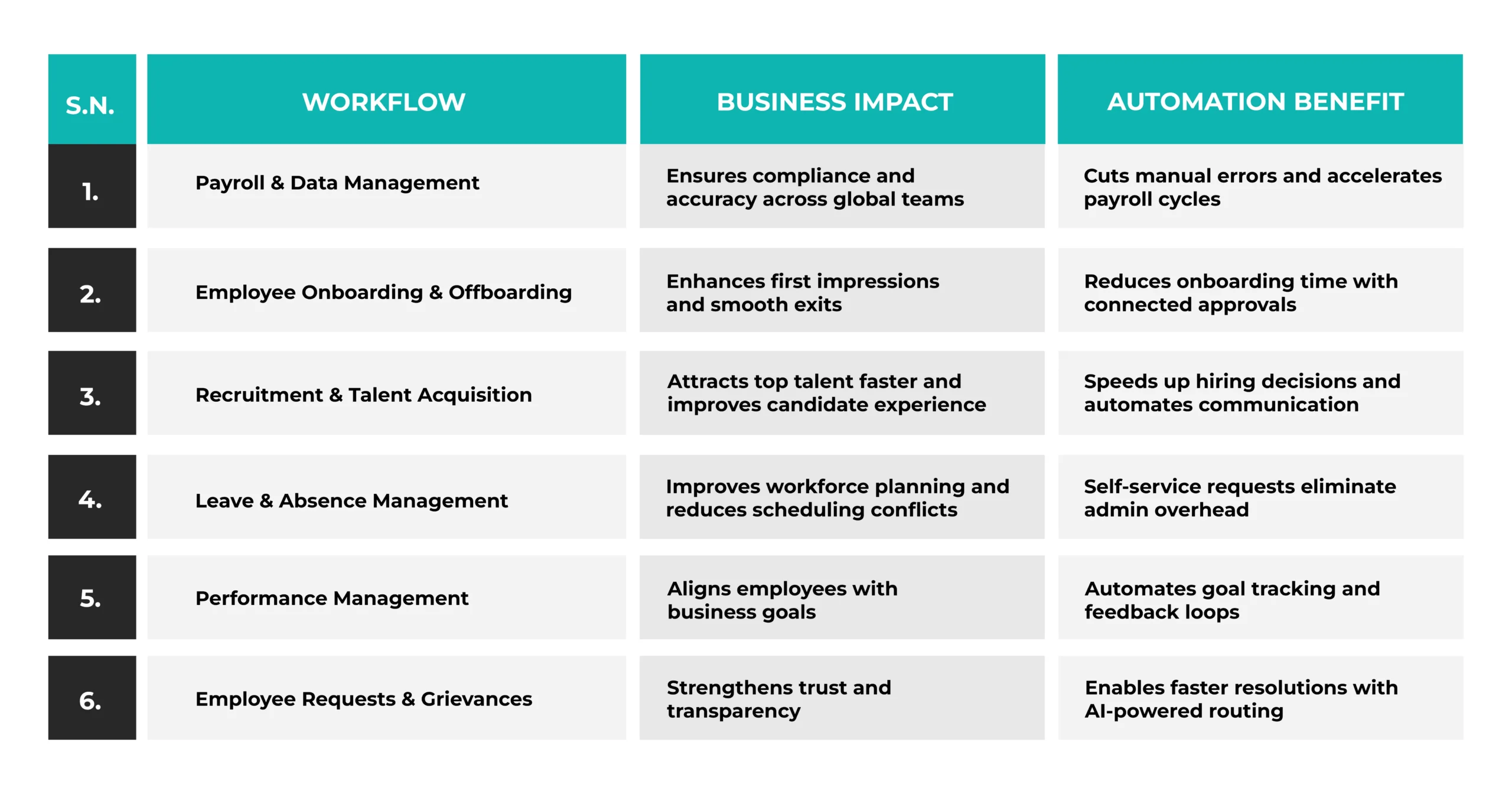HR has evolved from managing people to orchestrating seamless employee experiences that directly impact productivity, retention, and revenue.
Nearly 76% of employees now base their loyalty on the flexibility they have in when and where they work, transforming what enterprises think about employee experiences. Supporting a hybrid workforce and in-office teams is now a core part of HR workflows. Yet, many HR departments still steer through competing priorities: manual approvals, scattered systems, and repetitive queries.
In this blog, you’ll see the most common HR workflow examples, challenges behind them, and how to automate them with ServiceNow.
The ‘What’ and ‘How’ of HR Workflow Automation
HR workflow automation digitizes and connects processes like onboarding, offboarding, approvals, and payroll, so teams focus on moves from administration to enabling teams to drive strategic outcomes instead of chasing tickets.
With AI-powered tools such as self-service portals, Virtual Agents, and Employee Journey Management, the HR department delivers faster, more consistent, and personalized employee life cycles. Managers gain real-time insights, cross-department coordination improves, and employees feel supported no matter where they work.
Be a part of the HR leaders adopting smarter workflows
HR Workflow Examples Powering Enterprise Productivity
Businesses are under pressure to stay prepared for economic, technological, and talent disruptions. In fact, 50% of employees say their organization is prepared overall, but gaps remain. Automating HR processes improves efficiency and helps enterprises close these gaps, ensuring employees get timely support and leaders can act with full visibility.

HR Adminstration Workflows
These workflows are the backbone of HR operations: data, documentation, and coordination that keep employee services running smoothly. Administrative automation reduces manual errors, ensures compliance, and saves HR teams countless hours on repetitive tasks.
- Payroll processing: Automating salary disbursement, tax deductions, and payslip generation to ensure accuracy and timeliness.
- Personal data management workflows: Keeping employee information updated securely and maintaining compliance with data privacy regulations.
- Expense management: Streamlining expense submissions, approvals, and reimbursements with built-in validations.
- Employee communication: Delivering consistent, targeted updates and announcements to keep employees informed and engaged.
Did You Know?
CHROs who clearly define an HR-focused AI strategy, particularly by evolving the HR operating model, can gain significant productivity gains, predicting up to 29% improvement from AI adoption.
HR Operations Workflows
Workflows focus on daily HR activities that directly impact employee productivity and engagement. Operations automation enhances transparency, reduces delays, and empowers employees to self-serve.
- Leave and absence management: Automating time-off requests, approvals, and accrual tracking with clear visibility for managers.
- Employee onboarding & offboarding: Connecting departments to ensure a smooth start or exit experience with zero delays or data gaps.
- Performance management & reviews: Centralizing performance data, automating review cycles, and aligning goals with business outcomes.
- Employee self-service requests: Enabling employees to access HR services, submit requests, and get instant answers through digital channels.
- Employee training and development: Automating training enrolments, tracking progress, and delivering learning in the flow of work.
- Employee grievance resolution: Routing issues automatically to the right stakeholders for timely, transparent handling.
- Internal transfer/promotion: Coordinating approvals, role updates, and system access when employees move within the organization.
HR Hiring & Recruitment Workflows
These workflows power the talent lifecycle, from attracting candidates to onboarding them seamlessly. Recruitment automation speeds up hiring, ensures consistency across roles and regions, and improves candidate experience from application to onboarding.
- Talent acquisition and recruiting: Automating candidate screening, interview scheduling, and communication to accelerate hiring decisions.
- Recruitment workflows: Coordinating tasks between recruiters, hiring managers, and IT to ensure smooth offer management and onboarding.
How AI is Redefining HR Careers
AI is expected to free up at least 25% of HR employees’ time over the next 5 years, particularly in roles like recruiters and shared services representatives.
This shift opens the door to new and strategic HR roles including:
- AI Orchestration Designer
- HR Product Owner
- AI Ethics Officer
- Talent Strategist
By using AI augmentation, an HR shared services employee could save up to 28% of their weekly capacity, roughly 11 hours in a 40-hour week.
How ServiceNow Solves HR Workflow Challenges
Employees expect quick support, seamless access to information, and personalized experiences. That’s what ServiceNow HR Service Delivery (HRSD) is built for. It brings together all human resources workflow processes, from onboarding to offboarding, into a single, AI-powered platform. Your enterprise gets faster service delivery, greater operational efficiency, and a workforce that feels supported and engaged at every stage of their journey.
Here’s how ServiceNow HRSD helps enterprises overcome key HR workflow process challenges and deliver better employee experiences:
Challenge 1: Employees struggle to find the right answers and support
When employees can’t easily access HR information or help, it leads to frustration and repetitive service requests. HR inboxes get flooded with the same queries, slowing response times and reducing overall productivity.
ServiceNow Solution:
ServiceNow’s Employee Center acts as a unified portal where employees can find information, request services, and get instant support through an AI-powered Virtual Agent. It automates responses to routine requests, deflects common issues, and delivers consistent answers across channels, improving self-service adoption, employee satisfaction, and HR efficiency.
Challenge 2: Manual HR processes limit productivity and accuracy
Inefficient handling of onboarding, offboarding, leave approvals, and other HR tasks increases errors and consumes valuable time. This manual dependency prevents HR teams from focusing on more strategic goals like workforce planning and employee engagement.
ServiceNow Solution:
With automated HR workflows, repetitive tasks are digitized and routed to the right people at the right time. Automation eliminates manual steps, reduces errors, and improves transparency with real-time visibility into task progress. HR leaders can track performance, identify friction points early, and continuously optimize operations.
Challenge 3: Managers lack visibility to effectively support their teams
Without centralized insights, managers struggle to track tasks, performance, and employee journeys, especially across hybrid or global teams. This makes it difficult to address workforce needs promptly or deliver consistent guidance.
ServiceNow Solution:
The Manager Hub provides real-time insights, proactive prompts, and AI-driven recommendations. Managers can view team stats, open requests, and employee journeys in one place, empowering them to make data-driven decisions and provide timely support, no matter where employees work.
Challenge 4: Complex employee journeys cause friction across departments
Career events like promotions, transfers, or extended leaves often span multiple systems and departments. Without connected workflows, these transitions become stressful, error-prone, and inconsistent.
ServiceNow Solution:
Employee Journey Management connects and automates these complex processes end-to-end. It triggers proactive notifications, integrates cross-departmental tasks, and collects real-time feedback to continually improve the experience. With Vault for HR, sensitive employee data stays secure and transparent, ensuring compliance and trust.
See how ServiceNow transforms HR workflows
Challenge 5: Scaling HR services while maintaining personalization is difficult
Enterprises struggle to balance scale and individual experience. Generic communication and disconnected tools lead to inconsistent support and lower engagement across roles, locations, and departments.
ServiceNow Solution:
Through AI-driven content recommendations, targeted campaigns, and bulk case creation, ServiceNow helps HR teams scale services without losing personal touch. It allows organizations to deliver contextual, role-based information and maintain consistent employee experience at enterprise scale.
Additional ServiceNow HRSD Capabilities to Know
- Now Mobile: A customized mobile app to fulfill routine employee needs with powerful self-help and consolidated approvals.
- Performance Analytics: Monitor and track HR performance with dashboards, forecasts, and KPIs to identify opportunities where automation and self-service can improve efficiency.
- Process Mining: Gain AI-driven insights to visualize and optimize workflows, uncover inefficiencies, and perform root cause analysis and conformance checks for operational excellence.
- Alumni Service Center: Engage with former employees, contractors, and volunteers. Provide targeted content, services, and community connections.
The Way Forward for Modern HR Leaders
For HR to perform at its best, it needs freedom from repetitive tasks, endless forms, and overflowing inboxes. That’s exactly what ServiceNow does for you: speed, clarity, and consistency across every HR workflow.
At Aelum, we help organizations transform everyday HR processes into seamless, high-impact experiences. With AI handling the routine tasks, your people are empowered to focus on what truly matters, driving performance, culture, and growth.
We’ve partnered with enterprises to simplify operations, improve employee experiences, and strengthen retention, turning HR from a support function into a strategic advantage.
Talk to our ServiceNow HRSD experts and start your HR modernization journey today.
Frequently Asked Questions (FAQs)
1. What is an HR Workflow?
An HR workflow is a structured sequence of HR tasks and processes that ensures work is completed efficiently and consistently. It defines how activities like onboarding, payroll, leave approvals, and performance management flow from initiation to completion.
2. Why is an HR Workflow important?
HR workflows are important because they bring structure and efficiency to complex HR operations. They ensure that repetitive tasks are handled consistently, reduce delays, and provide employees and managers with clear guidance. HR workflows enhance productivity, employee satisfaction, and organizational agility by improving visibility and coordination across departments.
3. What are the benefits of automating HR Workflows?
Automating HR workflows eliminates manual tasks, reduces errors, and speeds up service delivery. Employees can access self-service portals, get instant answers, and complete requests quickly, while HR teams can focus on strategic initiatives. Automation also improves transparency, ensures compliance, and enhances overall workforce efficiency and engagement.
4. Which HR processes are commonly automated?
Commonly automated HR processes include onboarding and offboarding, leave and absence management, payroll processing, expense approvals, performance reviews, training and development tracking, and recruitment workflows. Automation also extends to employee self-service requests, internal transfers, and grievance handling, helping organizations standardize operations while improving employee experience.
5. What role do HR workflows play in compliance enhancements?
HR workflows support compliance by ensuring processes are executed consistently and according to regulations. Automated approvals, audit trails, and standardized documentation reduce the risk of errors and non-compliance. Workflows also provide visibility into regulatory requirements, maintain secure employee data, and make reporting and audits faster and more accurate.

































